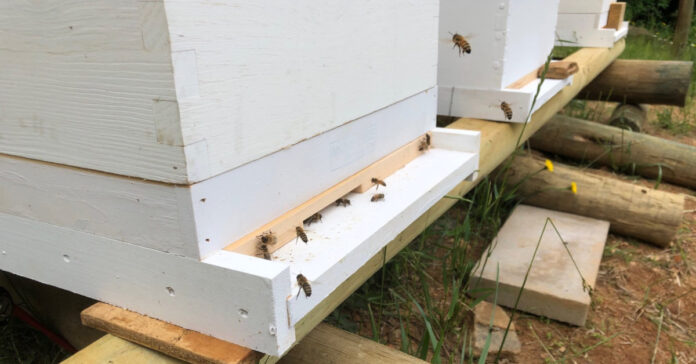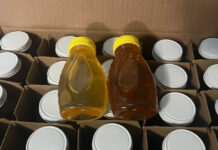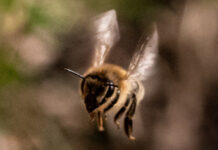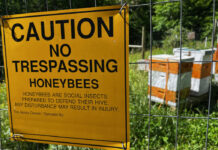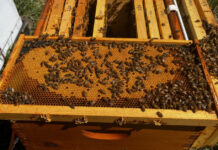The first bee hive is up and running. I picked it up early Thursday and brought it home, dodging raindrops. I waited until about 11 a.m. and installed them in their new hive quickly and easily.
Funny thing: By the time I got my jacket and veil on and marched out at the bee yard, my hive tool had fallen out of my back pocket. There I am with the nuc open and no way to pull out a frame. I unfolded my trusty pocket knife and used it to separate the frames and pry them out.
I don’t recommend prying with a folding knife any more than I recommend digging with it, but it held up well. Good knives, like good tools, are worth every penny.
I’m thinking if rigging up some kind of tool belt or belt pouch for my hive tools. Either that or storing them in the bee yard, possibly in an empty hive body. That way, everything will be handy.
Time to Feed the Bees
I had prepared syrup to feed the bees by mixing three quarts of water with an equal amount of sugar. (It works best to use hot water and add the sugar one cup at a time while stirring.) Once I got the bees established in their new hive, I fitted the hive-top feeder and filled it up.
I have followed the advice of Frederick Dunn and cut the top off a sock and fitted it to my feeder. This allows the syrup to wick its way up the cloth and gives the bees easy access without the danger of drowning.
The skies cleared up, and we got an hour of sunshine, so I did a walk-around at 4 p.m. There were some bees buzzing in and out of the hive entrance. Not huge numbers, but seeing bees flying in and out is reassuring.
I did not see any pollen on their legs as they flew in, so I took a box of pollen patties out of the freezer to defrost, just in case. I may feed half of one and see if they eat it. At 4 p.m., no bees were hitting the syrup. However, when I checked back at dusk, they were crowding around it, so I will take that as a good sign. It also makes me wonder if the bees will harvest the syrup all night long. After all, it’s dark in the hive all the time. Nothing is stopping them.
At my 4 p.m. inspection, I noticed a line of bees trying to squirm into the hive using a crack between the hive body and the feeding shim, which has the feeder on top of it, so something was made a little out of square. I came out at dusk and taped the crack closed with blue painter’s tape. We will see if they eat through it or let it be.
Syrup Equals Wax
For my hive to grow, they have to draw out comb, which means use their little wax glands to make what most novices would refer to as “honey comb.” In these hexagonal cells, they will store pollen, nectar which they will convert to honey, and the queen will lay eggs to generate even more bees.
Making wax and drawing comb is an energy-intensive exercise, but it is critical to the bees and to me as a bee keeper. The bees consumer large amounts of nectar and the sugar syrup I provide them to get the energy they need. (Syrup, nectar and honey is their source of carbohydrates while the pollen is their source of protein.)
Even if I cannot harvest a single pint of honey this year, if each hive fills two deep hive boxes and a super or two with comb, I will consider the year a success from a beekeeping perspective, but better yet if they all make it through the winter!
The Meat Shortage
I have not heard or seen much about the cyberattack and its effect on meat production. I guess we’re lucky that JBS started most of their plants back up on Wednesday. Also, I think gas lines just made more interesting news.
Instead, new coverage has focused on attacks on “essential services,” meaning, I guess, that the powers that be don’t thing ranging, farming and meat packing are essential, but subway in New York City and ferries in Boston are. A report in the Wall Street Journal warns the attacks are going to get worse.
What are Essential Services?
I think some of the most disruptive attacks would be on the cellular network, the Internet, airports, the stock exchange, the banking system, our water supply, and other utilities.
Other that stocking essentials goods, there is little you can do to stop a ransomware attack on a company you rely on, however you can make things easier on yourself should an attack hit. First, enhance your vehicle emergency kit with extra bottles of water (especially in hot locations) and extra food. Shelf-stable snacks that need little preparation are a good bet. Things like M&Ms (because they don’t melt in a hot car) to beef sticks, meal–replacement bars, a bag of nuts, dried fruit, and hard candy. Pick things you or your kids would want to eat. This way, if you get stuck somewhere, you will be more comfortable. Consider also a tarp or other shelter and spare blankets.
If you work outside the home, consider stashing some goods in your work place of in your car I the employee lot. Bottled water is probably a necessity but consider what you need to get home on foot, like comfortable shoes, weather-appropriate clothing, and possibly a concealed weapon.
Make back up plans with your loved ones so you all know where to go or what to do if the phones go down or the Internet backbone crashes.
California Faces Drought, Power Outages, and Fires
Every time I watch the news, I scratch my head and wonder, why would someone want to live in California?
Decades ago, I turned down a job in Orange County. I never regretted it. It seems that all the problems are country faces are just worse on the Left Coast.
As Axios points out, the drought is going to do far more harm than preventing farmers from raising crops. The dry conditions set the stage for another bad fire season and just when they need it most, falling water levels are likely to shut down hydroelectric power. Because California doesn’t have enough power outages.
This article on the drought has an astounding photo of boat docks sitting on dry land.

